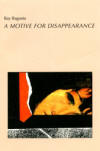A Motive for Disappearance
Ray Ragosta’s refreshing style of writing in A Motive for Disappearance prominently features sparse lines in what are typically short poems. Upon a second read-through of this book, a few lines from two of the pieces jumped out at me as Ragosta’s built-in description of his own work: “Their tales, a perfect infection of memory” and
Ray Ragosta’s refreshing style of writing in A Motive for Disappearance prominently features sparse lines in what are typically short poems. Upon a second read-through of this book, a few lines from two of the pieces jumped out at me as Ragosta’s built-in description of his own work: “Their tales, a perfect infection of memory” and
A voice tells me,
“You are playing at the borders,
straying into other fields.”
A cocoon grows around
and I inherit its living edges.
Ragosta’s work plays around the borders, embodies the edges, and infects its readers through the discovery process.
Part of the discovery includes fresh, seemingly simple descriptions that require readers to slow and savor their complexity. “Epilepsy of courage”: three seemingly simple words, and yet, they still grab my imagination. Another favorite of mine comes from the poem “Official North”:
The sky grays and your touch
is always your touch,
a little sweaty
but it still sends me into reverse.
On a less simple note, Ragosta’s poetry meets, and sometimes dances with, math, geometry, and physics. As a former math and physics nerd, I found this technique particularly pleasing. Even though terminology is prevalent, it doesn’t take someone well-versed in math to understand and delight in its usage. For instance, in the lines “The start and stop music plays / on this side of the equation / whose other half is half gone,” a reader doesn’t need to know about variables, distributive properties, balancing and solving equations to feel the disconcerting imbalance being expressed.
Ragosta’s accomplishment of this feat is a testament to his skillful control over his craft, and I would be remiss to not also mention the overarching complexities within the text. The heart of his work reveals itself through an intense, almost microscopic, look at “the borders.” Various elements are grounded in the everyday non-border world and then skew the norm ever so slightly. Two great examples of this come from one of Ragosta’s longer poems, “Now This Move”:
The crush of circumstance quickens.
Flowers line pathways to the possible.
Alternatives are closer than they appear:
A mirror reduces their size,
marking a rupture in wave.
And
Past navigates possibility;
all details are counted in,
but to find a recorder
with that kind of attention span . . .
may as well structure
accord’s final leap.
The final example from “Now This Move,” for me, also includes Ragosta’s awareness of the importance and challenge to have represented the borders through his collection. Ragosta created his collection of poetry with precision and clear attention given to his subjects. As a result, his readers can enjoy unlocking the puzzles within his poems.





